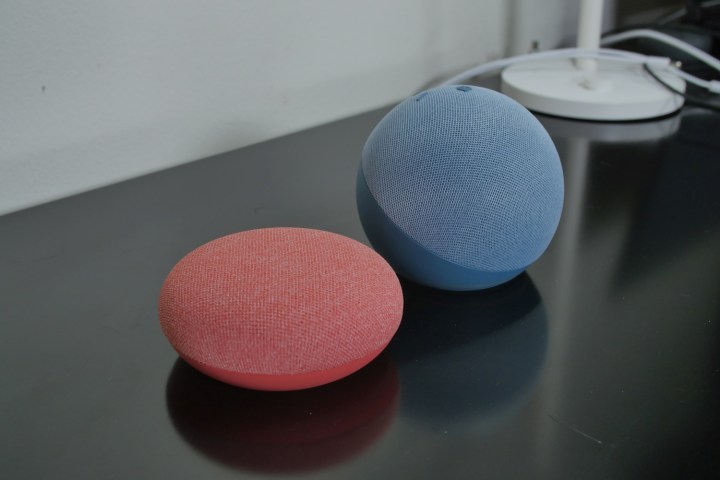While some of your fondest memories of home may be flicking a light switch off and on exactly 31 times before leaving a room, those days of physical input are quickly being relegated to the history books thanks to the smart home. One of the biggest conveniences of smart lighting is being able to control it all with your voice. Light systems like Philips Hue support all of the popular voice assistants like Apple’s Siri, Amazon’s Alexa, and Google Assistant. How do these systems work, how do you set them up, and can they really understand your commands? Here are the the answers to all of these questions and more.
What are voice-activated devices?

Voice-activated devices record a user’s audio commands and send those clips to remote servers to translate. It then returns commands or information to the device. In the case of smart lighting, a command can look like saying, “Hey Google, turn off all the lights,” to your Google Nest Mini, which then shoots the clip over your home Wi-Fi network to Google’s servers that translate it into a proper device command. That command is sent back to the Nest Mini, which figures out you want to do something with your smart light bulbs, sends that command to your lights, and voilà, your lights get turned off.
This process touches on the inevitable privacy question, as there are definite privacy concerns with multinational mega-corps hoarding user data as personal as voice clips. The big challenge is achieving enough processing power to process voice commands locally on the device without having to ship them off elsewhere. We’re getting to that point, but we’re not there yet.
How do you make a voice-activated light switch?
Voice activation of smart lights happens through one of three of the major voice assistants: Google Assistant, Apple’s Siri, or Amazon’s Alexa. Each one has a platform for those smart devices to work on alongside the rest of your smart home controls. Apple has HomeKit, Alexa has Skills, and Google has Home. These platforms handle your voice commands, and once translated, punt them to your smart lights to execute them.
Any given smart light needs to include support for one (or ideally all) of these platforms to support voice commands. These platforms are available on phones, tablets, computers, and smart speakers made by the appropriate manufacturer. Though you can, for example, issue Alexa commands through an Android app, you’re typically going to have a more seamless experience controlling your Alexa-connected lights through an Amazon Echo device.
Once you’ve installed your smart lights and connected them to the appropriate platform during the setup process, you should be good to go. The commands usually require a trigger word or pressing a physical button to put the devices in listening mode. “OK Google,” “Alexa,” or “Hey Siri” are all common trigger phrases. Commands are as simple as “turn on all my lights,” though the variety of control available is quite rich. Let’s take a look at the popular Philips Hue light bulbs as an example.
Can Philips Hue be voice-activated?
Yes, Philips Hue bulbs can be voice-activated. Philips Hue works with Amazon Alexa, Apple’s Siri, and Google Assistant after an initial setup process.
There are broad commands you can issue via voice, such as, “Turn off all the lights” and “turn on all the lights.” There’s a degree of brightness control too, so you can ask to “make the hallway brighter.” You can also issue commands for specific smart light recipes in specific areas, like, “Activate Relax in the living room.” Even if you don’t have a recipe set, you can tell Philips Hue to “turn the lights in the bedroom red” if you have a color smart bulb. If you just want to know what’s going on with your lights, ask, “Which lights in the kitchen are on?” Philips has a less-advertised feature called Gentle Sleep and Wake Up, which will gradually dim the lights with enough time to ease into the blissful void of sleep or awake peacefully in the morning. These settings can also be applied with voice commands.
How to voice activate Hue lights?
Activating Hue lights by voice is easy. To set it up, go into the Settings menu of the Hue app on your phone, and tap Voice Assistants. There you’ll find all three of your options. Pick the ones for the devices you use most. For example, choose Siri & HomeKit if you’re using an iPhone, or Alexa if you have an Echo Dot in the kitchen, for example. From there, follow the instructions, and you should be on your way.
Congratulations, you are now freed from the shackles of manual device fiddling and can summon the gift of light with a singular command.
Editors' Recommendations
- The best smart light switch for Alexa, Google Home, and HomeKit
- The Twinkly Matrix is a smart LED curtain with 500 mappable lights
- The best smart blinds for Google Home, Alexa, and HomeKit
- The best Amazon Alexa smart speakers
- How to deck out your pad with smart home gadgets for the holidays




